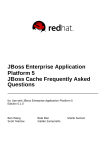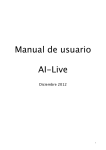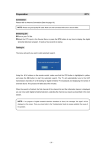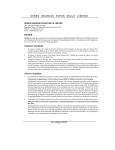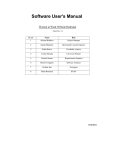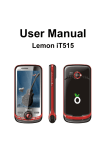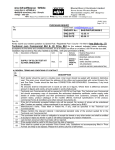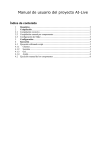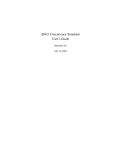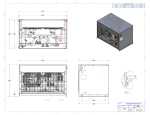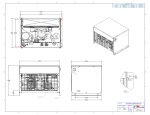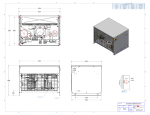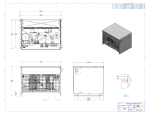Download OOAD_Chp6 - Shree Jaswal
Transcript
Slides by: Ms. Shree Jani‐ Jaswal
Chapter 6
Slides by:Ms. Shree Jani-Jaswal
1
Usability, Testing & Quality
Topics to be covered:
y Usability principles
y User interface evaluating user interfaces
y Testing & quality strategies
y Defects
y Test cases & test plan
y Inspections
y Quality assurance
Chapter 6
Slides by:Ms. Shree Jani-Jaswal
2
Chapter 6
Slides by:Ms. Shree Jani-Jaswal
3
User Centred Design
ySoftware development should focus on the needs of users
y Understand your users
y Design software based on an understanding of the
users’ tasks
y Ensure users are involved in decision making processes
y Design the user interface following guidelines for good
usability
y Have users work with and give their feedback about
prototypes, on‐line help and draft user manuals
Chapter 6
Slides by:Ms. Shree Jani-Jaswal
4
The importance of focusing on users
y Reduced training and support costs
y Reduced time to learn the system
y Greater efficiency of use
y Reduced costs by only developing features that are needed
y Reduced costs associated with changing the system later
y Better prioritizing of work for iterative development
y Greater attractiveness of the system, so users will be more
willing to buy and use it
Chapter 6
Slides by:Ms. Shree Jani-Jaswal
5
Characteristics of Users
ySoftware engineers must develop an understanding of
the users
y Goals for using the system
y Potential patterns of use
y Demographics
y Knowledge of the domain and of computers
y Physical ability
y Psychological traits and emotional feelings
Chapter 6
Slides by:Ms. Shree Jani-Jaswal
6
Basics of User Interface Design
y User interface design should be done in conjunction with
other software engineering activities.
y Do use case analysis to help define the tasks that the UI
must help the user perform.
y Do iterative UI prototyping to address the use cases.
y Results of prototyping will enable you to finalize the
requirements.
Chapter 6
Slides by:Ms. Shree Jani-Jaswal
7
Usability
vs.
Utility
yDoes the system provide the raw capabilities to allow
the user to achieve their goal?
y This is utility.
yDoes the system allow the user to learn and to use the
raw capabilities easily?
y This is usability.
y Both utility and usability are essential
y They must be measured in the context of particular types
of users.
Chapter 6
Slides by:Ms. Shree Jani-Jaswal
8
Aspects of usability
yUsability can be divided into separate aspects:
y Learnability
The speed with which a new user can become
proficient with the system.
y Efficiency of use
y How fast an expert user can do their work.
y Error handling
y The extent to which it prevents the user from making
errors, detects errors, and helps to correct errors.
y Acceptability.
y The extent to which users like the system.
y
Chapter 6
Slides by:Ms. Shree Jani-Jaswal
9
Different learning curves
Chapter 6
Slides by:Ms. Shree Jani-Jaswal
10
Some basic terminology of user
interface design
y Dialog: A specific window with which a user can
interact, but which is not the main UI window.
y Control or Widget: Specific components of a user
interface.
y Affordance: The set of operations that the user can do
at any given point in time.
y State: At any stage in the dialog, the system is
displaying certain information in certain widgets, and
has a certain affordance. Taken together these are
system’s user interface state
y Mode: A situation in which the UI restricts what the
user can do.
Chapter 6
Slides by:Ms. Shree Jani-Jaswal
11
Some basic terminology of user interface
design
y Modal dialog: A dialog in which the system is in a very
restrictive mode. The user cannot interact with any
other window until he or she has dismissed the modal
dialog.
y Feedback: The response from the system whenever the
user does something, is called feedback.
y Encoding techniques. Ways of encoding information
so as to communicate it to the user.
Chapter 6
Slides by:Ms. Shree Jani-Jaswal
12
Usability Principles
1. Do not rely only on usability guidelines – always
test with users.
y Usability guidelines have exceptions; you can only be confident
that a UI is good if you test it successfully with users.
2: Base UI designs on users’ tasks.
y Perform use case analysis to structure the UI.
3: Ensure that the sequences of actions to achieve a
task are as simple as possible.
y Reduce the amount of reading and manipulation the user has to
do.
y Ensure the user does not have to navigate anywhere to do
subsequent steps of a task.
Chapter 6
Slides by:Ms. Shree Jani-Jaswal
13
Usability Principles
4: Ensure that the user always knows what he or she
can and should do next.
y Ensure that the user can see what commands are available
and are not available.
y Make the most important commands stand out.
5: Provide good feedback including effective error
messages.
y Inform users of the progress of operations and of their
location as they navigate.
y When something goes wrong explain the situation in
adequate detail and help the user to resolve the problem.
Chapter 6
Slides by:Ms. Shree Jani-Jaswal
14
Usability Principles
6: Ensure that the user can always get out, go back
or undo an action.
y Ensure that all operations can be undone.
y Ensure it is easy to navigate back to where the user came
from.
7: Ensure that response time is adequate.
y Users are very sensitive to slow response time
y They compare your system to others.
y Keep response time less than a second for most
operations.
y Warn users of longer delays and inform them of progress.
Chapter 6
Slides by:Ms. Shree Jani-Jaswal
15
Usability Principles
8: Use understandable encoding techniques.
y Choose encoding techniques with care.
y Use labels to ensure all encoding techniques are fully
understood by users.
9: Ensure that the UI’s appearance is uncluttered.
y Avoid displaying too much information.
y Organize the information effectively.
Chapter 6
Slides by:Ms. Shree Jani-Jaswal
16
Usability Principles
10: Consider the needs of different groups of users.
y Accommodate people from different locales and people
with disabilities.
y Ensure that the system is usable by both beginners and
experts.
11: Provide all necessary help.
y Organize help well.
y Integrate help with the application.
y Ensure that the help is accurate.
Chapter 6
Slides by:Ms. Shree Jani-Jaswal
17
Usability Principles
12. Be consistent.
y Use similar layouts and graphic designs throughout your
application.
y Follow look‐and‐feel standards.
y Consider mimicking other applications.
Chapter 6
Slides by:Ms. Shree Jani-Jaswal
18
Some encoding techniques
y Text and fonts
y Icons
y Photographs
y Diagrams and abstract graphics
y Colors
y Grouping and bordering
y Spoken words
y Music
y Other sounds
y Animations and video
y Flashing
Chapter 6
Slides by:Ms. Shree Jani-Jaswal
19
Example
(bad UI)
Chapter 6
Slides by:Ms. Shree Jani-Jaswal
20
Example
(better UI)
Chapter 6
Slides by:Ms. Shree Jani-Jaswal
21
Evaluating User Interfaces
I) Heuristic evaluation
1. Pick some use cases to evaluate.
2. For each window, page or dialog that appears
during the execution of the use case
y Study it in detail to look for possible usability
defects.
3. When you discover a usability defect write down
the following information:
y A short description of the defect.
y Your ideas for how the defect might be fixed.
Chapter 6
Slides by:Ms. Shree Jani-Jaswal
22
Evaluating
User
Interfaces
II) Evaluation by observation of users
ySelect users corresponding to each of the
most important actors
ySelect the most important use cases
yWrite sufficient instructions about each of
the scenarios
yArrange evaluation sessions with users
yExplain the purpose of the evaluation
yPreferably videotape each session
Chapter 6
Slides by:Ms. Shree Jani-Jaswal
23
Evaluating User Interfaces
y Converse with the users as they are
performing the tasks
y When the users finish all the tasks, de‐
brief them
y Take note of any difficulties experienced
by the users
y Formulate recommended changes
Chapter 6
Slides by:Ms. Shree Jani-Jaswal
24
Implementing a Simple GUI in Java
yThe Abstract Window Toolkit (AWT)
y Component: the basic building blocks of any graphical
interface.
y
Button, TextField, List, Label, ScrollBar.
y Container: contain the components constituting the GUI
y
Frame, Dialog and Panel
y LayoutManager: define the way components are laid out
in a container.
y
GridLayout, BorderLayout
Chapter 6
Slides by:Ms. Shree Jani-Jaswal
25
Example
public class ClientGUI extends Frame implements ChatIF
{
private Button closeB = new Button("Close");
private Button openB = new Button("Open");
private Button sendB = new Button("Send");
private Button quitB = new Button("Quit");
private TextField portTxF = new TextField("12345");
private TextField hostTxF = new TextField("localhost");
private TextField message = new TextField();
private Label portLB = new Label("Port: ", Label.RIGHT);
private Label hostLB = new Label("Host: ", Label.RIGHT);
private Label messageLB = new Label("Message: ",
Label.RIGHT);
private List messageList = new List();
...
}
Chapter 6
Slides by:Ms. Shree Jani-Jaswal
26
Example
public ClientGUI(String host, int port)
{
super("Simple Chat");
setSize(300,400);
setVisible(true);
setLayout(new BorderLayout(5,5));
Panel bottom = new Panel();
add("Center", messageList);
add("South", bottom);
bottom.setLayout(new GridLayout(5,2,5,5))
bottom.add(hostLB);
bottom.add(hostTxF);
bottom.add(portLB);
bottom.add(portTxF);
bottom.add(messageLB);
bottom.add(message);
bottom.add(openB);
bottom.add(sendB);
bottom.add(closeB);
bottom.add(quitB);
...
}
Chapter 6
Slides by:Ms. Shree Jani-Jaswal
27
sendB.addActionListener(new ActionListener()
{
public void actionPerformed(ActionEvent e)
{
send();
}
});
Example
}
public void send()
{
try
{
client.sendToServer(message.getText());
}
catch (Exception ex)
{
messageList.add(ex.toString());
messageList.makeVisible(messageList.getItemCount()-1);
messageList.setBackground(Color.yellow);
}
}
Chapter 6
Slides by:Ms. Shree Jani-Jaswal
28
Difficulties and Risks in UI Design
y Users differ widely
Resolution:
y Account for differences among users when you design the
system.
y Design it for internationalization.
y When you perform usability studies, try the system with
many different types of users.
y User interface implementation technology changes
rapidly
Resolution:
y Stick to simpler UI frameworks widely used by others.
y Avoid fancy and unusual UI designs involving specialized
controls that will be hard to change.
Chapter 6
Slides by:Ms. Shree Jani-Jaswal
29
Difficulties and Risk in UI design
y User interface design and implementation can often
take the majority of work in an application:
Resolution:
y Make UI design an integral part of the software engineering
process.
y Allocate time for many iterations of prototyping and evaluation.
y Developers often underestimate the weaknesses of a
GUI
Resolution:
y Ensure all software engineers have training in UI development.
y Always test with users.
y Study the UIs of other software.
Chapter 6
Slides by:Ms. Shree Jani-Jaswal
30
Chapter 6
Slides by:Ms. Shree Jani-Jaswal
31
Basic definitions
y A failure is an unacceptable behaviour exhibited by a system
The frequency of failures measures the reliability
y An important design objective is to achieve a very low
failure rate and hence high reliability.
y A failure can result from a violation of an explicit or implicit
requirement
y A defect is a flaw in any aspect of the system that contributes,
or may potentially contribute, to the occurrence of one or
more failures
y It might take several defects to cause a particular failure
y An error is a slip‐up or inappropriate decision by a software
developer that leads to the introduction of a defect
y
Chapter 6
Slides by:Ms. Shree Jani-Jaswal
32
Effective and Efficient Testing
yTo test effectively, you must use a strategy that uncovers
as many defects as possible.
yTo test efficiently, you must find the largest possible
number of defects using the fewest possible tests
y Testing is like detective work:
y The tester must try to understand how programmers
and designers think, so as to better find defects.
y The tester must not leave anything uncovered, and
must be suspicious of everything.
y It does not pay to take an excessive amount of time;
tester has to be efficient.
Chapter 6
Slides by:Ms. Shree Jani-Jaswal
33
Black-box testing
yTesters provide the system with inputs and observe the
outputs
y They can see none of:
y
y
y
The source code
The internal data
Any of the design documentation describing the system’s
internals
Chapter 6
Slides by:Ms. Shree Jani-Jaswal
34
Glass-box testing
yAlso called ‘white‐box’ or ‘structural’ testing
yTesters have access to the system design
y They can
y
y
y
Examine the design documents
View the code
Observe at run time the steps taken by algorithms and their
internal data
y Individual programmers often informally employ glass‐
box testing to verify their own code
Chapter 6
Slides by:Ms. Shree Jani-Jaswal
35
Equivalence classes
y It is a black‐box testing method
y It is inappropriate to test by brute force, using every possible
input value
y Takes a huge amount of time
y Is impractical
y Is pointless!
y You should divide the possible inputs into groups which you
believe will be treated similarly by all algorithms.
y Such groups are called equivalence classes.
y A tester needs only to run one test per equivalence class
y The tester has to
y understand the required input,
y appreciate how the software may have been designed
Chapter 6
Slides by:Ms. Shree Jani-Jaswal
36
Examples of equivalence classes
y Example: to test a Java method validMonth that
takes an int argument which is supposed to
correspond to a valid month.
y The method returns true if the input is in range
1 to 12 inclusive & false otherwise
y So Equivalence classes are: [‐∞..0], [1..12], [13..
∞]
y Valid input is a month number (1‐12)
Chapter 6
Slides by:Ms. Shree Jani-Jaswal
37
Combinations of equivalence
classes
y Combinatorial explosion means that you cannot
realistically test every possible system‐wide equivalence
class.
y
If there are 4 inputs with 5 possible values there are 54 (i.e. 625)
possible system‐wide equivalence classes.
y You should first make sure that at least one test is run with
every equivalence class of every individual input.
y You should also test all combinations where an input is
likely to affect the interpretation of another.
y You should test a few other random combinations of
equivalence classes.
Chapter 6
Slides by:Ms. Shree Jani-Jaswal
38
Example equivalence class combinations
y Designing a system that is to contain info about all
kinds of land vehicles, including passenger vehicles &
racing vehicles
y Such a system might require the user to enter
specifications of a new type of vehicle
y Your job is to divide this system into equivalence classes
for testing
Chapter 6
Slides by:Ms. Shree Jani-Jaswal
39
Example equivalence class
combinations
y One valid input is either ‘Metric’ or ‘US/Imperial’
y Equivalence classes are:
y Metric, US/Imperial, Other
y Another valid input is maximum speed: 1 to 750 km/h or
1 to 500 mph
y
y
Validity depends on whether metric or US/imperial
Equivalence classes are:
y [‐∞..0], [1..500], [501..750], [751.. ∞]
y Some test combinations
y Metric, [1..500]
y US/Imperial, [501..750]
y Metric, [501..750]
y Metric, [501..750]
Chapter 6
Slides by:Ms. Shree Jani-Jaswal
valid
invalid
valid
valid
40
Testing at boundaries of
equivalence classes
y More errors in software occur at the boundaries of
equivalence classes
y The idea of equivalence class testing should be expanded
to specifically test values at the extremes of each
equivalence class
y
E.g. The number 0 often causes problems
y E.g.: If the valid input is a month number (1‐12)
y
y
Test equivalence classes as before
Test 0, 1, 12 and 13 as well as very large positive and negative
values
Chapter 6
Slides by:Ms. Shree Jani-Jaswal
41
Detecting specific categories of
defects
yA tester must try to uncover any defects the other
software engineers might have introduced.
y This means designing tests that explicitly try to catch a
range of specific types of defects that commonly occur
Chapter 6
Slides by:Ms. Shree Jani-Jaswal
42
A: Defects in Ordinary
Algorithms
Incorrect logical conditions
1.
Defect:
y
y
The logical conditions that govern looping and if‐then‐else
statements are wrongly formulated.
Testing strategy:
y
y
y
Use equivalence class and boundary testing.
Consider as an input each variable used in a rule or logical
condition.
Chapter 6
Slides by:Ms. Shree Jani-Jaswal
43
Example of incorrect logical
conditions
defect
yWhat is the hard‐to‐find defect in the following code?
y An aircraft’s alarm is supposed to sound if the landing gear
is not deployed when the aircraft is close to the ground.
The specifications might state this as follows:
y
The landing gear must be deployed whenever the plane is within 2
minutes from landing or takeoff, or within 2000 feet from the
ground. If visibility is less than 1000 feet, then the landing gear
must be deployed whenever the plane is within 3 minutes from
landing or lower than 2500 feet
Chapter 6
Slides by:Ms. Shree Jani-Jaswal
44
if(!landingGearDeployed &&
(min(nowtakeoffTime,estLandTimenow))<
(visibility < 1000 ?
180 :120) ||
relativeAltitude <
(visibility < 1000 ?
2500 :2000)
)
{
throw
new
LandingGearException();
}
a
visibility < 1000 ft
b
d
e
c
h
Ground altitude
< 2 minsi
j < 2000 ft
2 - 3 mins after orf prior
altitude 2000 - 2500 ft
to takeoff
g
Chapter 6
Slides by:Ms. Shree Jani-Jaswal
45
Defects in Ordinary Algorithms
2.
Performing a calculation in the wrong part of a
control construct
Defect:
y
y
y
The program performs an action when it should not, or does not
perform an action when it should.
Typically caused by inappropriately excluding or including the
action from a loop or a if construct.
Testing strategies:
y
y
y
y
Design tests that execute each loop zero times, exactly once, and
more than once.
Anything that could happen while looping is made to occur on
the first, an intermediate, and the last iteration.
This kind of defect may be reliably caught by glass‐box testing
Chapter 6
Slides by:Ms. Shree Jani-Jaswal
46
Example of performing a
calculation in the wrong part of
a control construct
while(j<maximum)
{
k=someOperation(j);
j++;
}
if(k==-1) signalAnError();
Chapter 6
Slides by:Ms. Shree Jani-Jaswal
47
Defects in Ordinary Algorithms
Not terminating a loop or recursion
y Defect:
y A loop or a recursion does not always terminate, i.e. it
is ‘infinite’.
y Testing strategies:
y Analyse what causes a repetitive action to be stopped.
y Run test cases that you anticipate might not be
handled correctly.
y Eg: in a program for counting total no of atoms in a
complex organic molecule, it must be tested if the
program goes into infinite loop due to circular
molecular structures
3.
Chapter 6
Slides by:Ms. Shree Jani-Jaswal
48
Defects in Ordinary Algorithms
Not setting up the correct preconditions for an
algorithm
y Defect:
y Preconditions: state what must be true before the
algorithm should be executed.
y A defect would exist if a program proceeds to do its
work, even when the preconditions are not satisfied.
y Testing strategy:
y Run test cases in which each precondition is not
satisfied.
y Preferably its i/p values are just beyond what the
algorithm can accept
4.
Chapter 6
Slides by:Ms. Shree Jani-Jaswal
49
Defects in Ordinary Algorithms
5. Not handling null conditions
y
Defect:
y A null condition is a situation where there normally are
one or more data items to process, but sometimes there
are none.
y It is a defect when a program behaves abnormally when
a null condition is encountered.
Testing strategy:
y Determine all possible null conditions & run test cases
that would highlight any inappropriate behaviour.
y Eg: divide byChapter
zero6 error
y
Slides by:Ms. Shree Jani-Jaswal
50
Defects in Ordinary Algorithms
Not handling singleton or non‐singleton conditions
y Defect:
y A singleton condition occurs when there is normally more
than one of something, but sometimes there is only one.
y A non‐singleton condition is the inverse.
y Defects occur when the unusual case is not properly
handled.
y Testing strategy:
y Brainstorm to determine unusual conditions and run
appropriate tests.
6.
y
Eg: a prog is designed to randomly assign members of a sports club
into pairs who will play against each other. Does the prog do
something intelligent with the left‐over person when there are odd
no. of members. Chapter 6
Slides by:Ms. Shree Jani-Jaswal
51
Defects in Ordinary Algorithms
7.
Off‐by‐one errors
Defect:
y
y
y
y
A program inappropriately adds or subtracts one.
Or loops one too many times or one too few times.
This is a particularly common type of defect.
Testing strategy:
y
y
Develop boundary tests in which you verify that the program:
y
computes the correct numerical answer.
y
performs the correct number of iterations.
Chapter 6
Slides by:Ms. Shree Jani-Jaswal
52
Example of off-by-one defect
Eg 1:
for (i=1; i<arrayname.length; i++)
{
/* do something */
}
Use Iterators to help eliminate these defects
Eg 2:
while (iterator.hasNext())
{
anOperation(++val);
}
Variable val is incremented too early so its initial value is not actually
passed to anOperation
Chapter 6
Slides by:Ms. Shree Jani-Jaswal
53
Defects
in
Ordinary
Algorithms
8. Operator precedence errors
Defect:
y An operator precedence error occurs when a
programmer omits needed parentheses, or puts
parentheses in the wrong place.
y Operator precedence errors are often extremely
obvious...
y but can occasionally lie hidden until special
conditions arise.
y E.g. If x*y+z should be x*(y+z) this would be hidden if
z was normally zero.
y Testing:
y In software that computes formulae, run tests that
anticipateChapter
such6 defects.
y
Slides by:Ms. Shree Jani-Jaswal
54
Defects in Ordinary Algorithms
9.
Use of inappropriate standard algorithms
Defect:
y
y
An inappropriate standard algorithm is one that is
unnecessarily inefficient or has some other property that is
widely recognized as being bad.
Testing strategies:
y
y
The tester has to know the properties of algorithms and
design tests that will determine whether any undesirable
algorithms have been implemented.
Chapter 6
Slides by:Ms. Shree Jani-Jaswal
55
Example of inappropriate
standard algorithms
y An inefficient sort algorithm
y
The most classical ‘bad’ choice of algorithm is sorting using a
so‐called ‘bubble sort’
y An inefficient search algorithm
y
y
Ensure that the search time does not increase unacceptably as
the list gets longer
Check that the position of the searched item does not have a
noticeable impact on search time.
y A non‐stable sort
y A search or sort that is case sensitive when it should not
be, or vice versa
Chapter 6
Slides by:Ms. Shree Jani-Jaswal
56
B: Defects in Numerical
Algorithms
Not using enough bits or digits
y Defect:
y A system does not use variables capable of
representing the largest values that could be stored.
y When the capacity is exceeded, an unexpected
exception is thrown, or the data stored is incorrect.
y Testing strategies:
y Test using very large numbers to ensure the system
has a wide enough margin of error.
1.
Chapter 6
Slides by:Ms. Shree Jani-Jaswal
57
Defects in Numerical
Algorithms
2. Not using enough places after the decimal point
or significant figures
y Defects:
y A floating point value might not have the capacity
to store enough significant figures.
y A fixed point value might not store enough places
after the decimal point.
y
A typical manifestation is excessive rounding.
y Testing strategies:
y Perform calculations that involve many significant
figures, and large differences in magnitude.
y Verify that the calculated results are correct.
Chapter 6
Slides by:Ms. Shree Jani-Jaswal
58
Defects in Numerical
Algorithms
Ordering operations poorly so errors build up
y
Defect:
y
A large number does not store enough significant figures to
be able to accurately represent the result.
y
This defect occurs when you do small operations on large
floating point numbers & excessive rounding or truncation
errors build up.
y
Testing strategies:
y
Make sure the program works with inputs that have large
positive and negative exponents.
y
Have the program work with numbers that vary a lot in
magnitude.
y
Make sure computations
are still accurately performed.
Chapter 6
3.
Slides by:Ms. Shree Jani-Jaswal
59
Defects in Numerical
Algorithms
Assuming a floating point value will be exactly
equal to some other value
y Defect:
y If you perform an arithmetic calculation on a
floating point value, then the result will very rarely
be computed exactly.
y To test equality, you should always test if it is within
a small range around that value.
y Testing strategies:
y Standard boundary testing should detect this type
of defect.
4.
Chapter 6
Slides by:Ms. Shree Jani-Jaswal
60
Example of defect in testing
floating value equality
Bad:
for (double d = 0.0; d != 10.0; d+=2.0) {...}
Better:
for (double d = 0.0; d < 10.0; d+=2.0) {...}
Chapter 6
Slides by:Ms. Shree Jani-Jaswal
61
C: Defects in Timing and Coordination
1.
Deadlock and livelock
Defects:
y
y
y
A deadlock is a situation where two or more threads are
stopped, waiting for each other to do something.
y
The system is hung
Livelock is similar, but now the system can do some
computations, but can never get out of some states.
Chapter 6
Slides by:Ms. Shree Jani-Jaswal
62
Example of deadlock
A:Thread
O:
P:
B:Thread
lock
lock
waiting
to lock O:
waiting
to lock P:
Chapter 6
Slides by:Ms. Shree Jani-Jaswal
63
Defects in Timing and Coordination
yDeadlock and livelock
y Testing strategies:
y Deadlocks and livelocks occur due to unusual combinations of
conditions that are hard to anticipate or reproduce.
y It is often most effective to use inspection to detect such
defects, rather than testing alone.
y However, when doing black‐box testing:
y Vary the time consumption of different threads.
y Run a large number of threads concurrently.
y Deliberately deny resources to one or more threads.
y If its cost is justifiable, glass‐box testing is one of the best ways
to uncover these defects
Chapter 6
Slides by:Ms. Shree Jani-Jaswal
64
Defects in Timing and Coordination
2.
Critical races
Defects:
y
y
One thread experiences a failure because another thread
interferes with the ‘normal’ sequence of events.
Testing strategies:
y
y
y
y
It is particularly hard to test for critical races using black box
testing alone.
One possible, although invasive, strategy is to deliberately
slow down one of the threads.
Use inspection.
Chapter 6
Slides by:Ms. Shree Jani-Jaswal
65
Example of critical race
A:Thread
Data:
B:Thread
A:Thread
Data:
B:Thread
set
get
get
set
a) Normal
Chapter 6
Slides by:Ms. Shree Jani-Jaswal
b) Abnormal due to delay in thread A
66
Semaphore and
synchronization
yCritical races can be prevented by locking data so that
they cannot be accessed by other threads when they are
not ready
y One widely used locking mechanism is called a
semaphore.
y In Java, the synchronized keyword can be used.
y
It ensures that no other thread can access an object until the
synchronized method terminates.
Chapter 6
Slides by:Ms. Shree Jani-Jaswal
67
Example of a synchronized
method
A:Thread
Data:
B:Thread
A:Thread
get
Data:
B:Thread
get
waiting for A:
to complete its
synchronized
operation
get
calc
calc
put
put
calc
put
get
put
a) Abnormal: The value put by
thread A is immediately
overwritten by the value put
by thread B.
calc
b) The problem has been solved
by accessing the data using
synchronized methods
Chapter 6
Slides by:Ms. Shree Jani-Jaswal
68
D: Defects in Handling Stress
and Unusual Situations
Insufficient throughput or response time on
minimal configurations
y Defect:
y On a minimal configuration, the system’s
throughput or response time fail to meet
requirements.
y Testing strategy:
y Perform testing using minimally configured
platforms.
1.
Chapter 6
Slides by:Ms. Shree Jani-Jaswal
69
Defects in Handling Stress and Unusual
Situations
Incompatibility with specific configurations of
hardware or software
y Defect:
y The
system works properly with particular
configurations of hardware, operating systems and
external libraries but fails if it is run using other
configurations
y Testing strategy:
y Extensively execute the system with all possible
configurations that might be encountered by users.
y Eg: a system might fail if a different graphics card is
Chapter 6
installed.
Slides by:Ms. Shree Jani-Jaswal
2.
70
Defects in Handling Stress and Unusual
Situations
Defects in handling peak loads or missing resources
y Defects:
y The system does not gracefully handle resource
shortage.
y Resources that might be in short supply include:
y memory, disk space or network bandwidth,
permission.
y The program being tested should report the problem in
a way the user will understand.
y Testing strategies:
y Devise a method of denying the resources.
y Run a very large number of copies of the program being
tested, all at the same time.
3.
Chapter 6
Slides by:Ms. Shree Jani-Jaswal
71
Defects in Handling Stress and Unusual
Situations
Inappropriate management of resources
y Defect:
y A program uses certain resources but does not make
them available when it no longer needs them.
y A memory leak is a special case of inappropriate
management of resources
y
Testing strategy:
y Run the program intensively in such a way that it uses
many resources, relinquishes them and then uses them
again repeatedly.
4.
y
Eg: a program might open many files, but not close them so as to
enable other programs to open them.
Chapter 6
Slides by:Ms. Shree Jani-Jaswal
72
Defects in Handling Stress and
Unusual
Situations
5. Defects in the process of recovering from a crash
Defects:
y Any system will undergo a sudden failure if its
hardware fails, or if its power is turned off.
y It is a defect if the system is left in an unstable state
and hence is unable to fully recover.
y It is also a defect if a system does not correctly deal
with the crashes of related systems.
y Testing strategies:
y Kill a program at various times during execution.
y Try turning the power off, however operating systems
themselves are often intolerant of doing that.
y
Chapter 6
Slides by:Ms. Shree Jani-Jaswal
73
E: Documentation defects
y Defect:
y
The software has a defect if the user manual, reference manual
or on‐line help:
y gives incorrect information
y fails to give information relevant to a problem.
y Testing strategy:
y
y
Examine all the end‐user documentation, making sure it is
correct.
Work through the use cases, making sure that each of them is
adequately explained to the user.
Chapter 6
Slides by:Ms. Shree Jani-Jaswal
74
Writing Formal Test Cases and
Test Plans
yA test case is an explicit set of instructions designed to
detect a particular class of defect in a software system.
y A test case can give rise to many tests.
y Each test is a particular running of the test case on a
particular version of the system.
Chapter 6
Slides by:Ms. Shree Jani-Jaswal
75
Test
plans
yA test plan is a document that contains a complete set of test
cases for a system
y Along with other information about the testing process.
y The test plan is one of the standard forms of documentation.
y If a project does not have a test plan:
y Testing will inevitably be done in an ad‐hoc manner.
y Leading to poor quality software.
y The test plan should be written long before the testing starts.
y You can start to develop the test plan once you have
developed the requirements.
Chapter 6
Slides by:Ms. Shree Jani-Jaswal
76
Information to include in a
formal test case
A. Identification and classification:
Each test case should have a number, and may also be
given a descriptive title.
y The system, subsystem or module being tested should
also be clearly indicated.
y The importance of the test case should be indicated.
B. Instructions:
y Tell the tester exactly what to do.
y The tester should not normally have to refer to any
documentation in order to execute the instructions.
y
Chapter 6
Slides by:Ms. Shree Jani-Jaswal
77
Information to include in a formal test
case
C. Expected result:
y Tells the tester what the system should do in response
to the instructions.
y The tester reports a failure if the expected result is not
encountered.
D. Cleanup (when needed):
y Tells the tester how to make the system go ‘back to
normal’ or shut down after the test.
Chapter 6
Slides by:Ms. Shree Jani-Jaswal
78
Levels of importance of test
cases
Level 1:
y
y
y
y
First pass critical test cases.
Designed to verify the system runs and is safe.
No further testing is possible.
y Level 2:
y
y
y
General test cases.
Verify that day‐to‐day functions correctly.
Still permit testing of other aspects of the system.
y Level 3:
y
y
y
Detailed test cases.
Test requirements that are of lesser importance.
The system functions most of the time but has not yet met
quality objectives.
Chapter 6
Slides by:Ms. Shree Jani-Jaswal
79
Determining test cases
enumerating attributes
by
yIt is important that the test cases test every aspect of
the requirements.
y Each detail in the requirements is called an attribute.
y An attribute can be thought of as something that is
testable.
y A good first step when creating a set of test cases is to
enumerate the attributes.
y A way to enumerate attributes is to circle all the
important points in the requirements document.
y However there are often many attributes that are implicit.
Chapter 6
Slides by:Ms. Shree Jani-Jaswal
80
Strategies for Testing Large
Systems
yBig bang testing versus integration testing
y In big bang testing, you take the entire system and test it
as a unit
y A better strategy in most cases is incremental testing:
y
y
y
You test each individual subsystem in isolation
Continue testing as you add more and more
subsystems to the final product
Incremental testing can be performed horizontally
or vertically, depending on the architecture
Chapter 6
Slides by:Ms. Shree Jani-Jaswal
81
Strategies for Testing Large
Systems
y Horizontal testing can be used when the system is
divided into separate sub‐applications
y There are several strategies for vertical incremental
testing:
y Top‐down
y Bottom‐up
y sandwich
Chapter 6
Slides by:Ms. Shree Jani-Jaswal
82
Top down testing
y Start by testing just the user interface.
y The underlying functionality are simulated by stubs.
y
y
Pieces of code that have the same interface as the
lower level functionality.
Do not perform any real computations or
manipulate any real data.
y Then you work downwards, integrating lower and lower
layers.
y The big drawback to top down testing is the cost of
writing the stubs.
Chapter 6
Slides by:Ms. Shree Jani-Jaswal
83
Bottom-up testing
y Start by testing the very lowest levels of the software.
y You needs drivers to test the lower layers of software.
y
Drivers are simple programs designed specifically
for testing that make calls to the lower layers.
y Drivers in bottom‐up testing have a similar role to stubs in
top‐down testing, and are time‐consuming to write.
Chapter 6
Slides by:Ms. Shree Jani-Jaswal
84
Sandwich testing
y Sandwich testing is a hybrid between bottom‐up and top
down testing.
y Test the user interface in isolation, using stubs.
y Test the very lowest level functions, using drivers.
y When the complete system is integrated, only the middle
layer remains on which to perform the final set of tests.
Chapter 6
Slides by:Ms. Shree Jani-Jaswal
85
Vertical strategies for incremental integration
testing
Top-down testing
Bottom-up testing
Sandwich testing
driver driver driver
UI Layer
UI Layer
stub stub stub
Database Network
layer
layer
stub stub stub
UI Layer
driver driver driver
driver driver driver
Functional layer
Functional layer
stub stub stub
Database Network
layer
layer
Database Network
layer
layer
UI Layer
Fully Functional layer
integrated
Database Network
system
layer
Chapter 6
Slides by:Ms. Shree Jani-Jaswal
layer
86
The test-fix-test cycle
yWhen a failure occurs during testing:
y Each failure report is entered into a failure tracking
system.
y It is then screened and assigned a priority.
y Low‐priority failures might be put on a known bugs list
that is included with the software’s release notes.
y Some failure reports might be merged if they appear to
result from the same defects.
y Somebody is assigned to investigate a failure.
y That person tracks down the defect and fixes it.
y Finally a new version of the system is created, ready to
be tested again.
Chapter 6
Slides by:Ms. Shree Jani-Jaswal
87
The ripple effect
yThere is a high probability that the efforts to remove
the defects may have actually added new defects
y The maintainer tries to fix problems without fully
understanding the ramifications of the changes
y The maintainer makes ordinary human errors
y The system regresses into a more and more failure‐prone
state
Chapter 6
Slides by:Ms. Shree Jani-Jaswal
88
Regression testing
y It tends to be far too expensive to re‐run every single test
case every time a change is made to software.
y Hence only a subset of the previously‐successful test cases is
actually re‐run.
y This process is called regression testing.
y
The tests that are re‐run are called regression tests.
y Regression test cases are carefully selected to cover as much
of the system as possible.
The “law of conservation of bugs”:
y The number of bugs remaining in a large system is
proportional to the number of bugs already fixed
Chapter 6
Slides by:Ms. Shree Jani-Jaswal
89
Deciding when to stop testing
y All of the level 1 test cases must have been successfully
executed.
y Certain pre‐defined percentages of level 2 and level 3 test
cases must have been executed successfully.
y The targets must have been achieved and are maintained
for at least two cycles of ‘builds’.
y
y
A build involves compiling and integrating all the components.
Failure rates can fluctuate from build to build as:
y Different sets of regression tests are run.
y New defects are introduced.
Chapter 6
Slides by:Ms. Shree Jani-Jaswal
90
The roles of people involved in
testing
y The first pass of unit and integration testing is called
developer testing.
y
Preliminary testing performed by the software developers who
do the design.
y Independent testing is performed by a separate group.
y
y
They do not have a vested interest in seeing as many test cases
pass as possible.
They develop specific expertise in how to do good testing, and
how to use testing tools.
Chapter 6
Slides by:Ms. Shree Jani-Jaswal
91
Testing performed by users and
clients
y Alpha testing
y Performed by the user or client, but under the supervision of
the software development team.
y Beta testing
y Performed by the user or client in a normal work environment.
y Recruited from the potential user population.
y An open beta release is the release of low‐quality software to
the general population.
y Acceptance testing
y Performed by users and customers.
y However, the customers do it on their own initiative.
Chapter 6
Slides by:Ms. Shree Jani-Jaswal
92
Inspections
yAn inspection is an activity in which one or more
people systematically
y Examine source code or documentation, looking for
defects.
y Normally, inspection involves a meeting...
y
Although participants can also inspect alone at their desks.
Chapter 6
Slides by:Ms. Shree Jani-Jaswal
93
Roles on inspection teams
y The author
y The moderator.
Calls and runs the meeting.
y Makes sure that the general principles of inspection are
adhered to.
y The secretary.
y Responsible for recording the defects when they are
found.
y Must have a thorough knowledge of software engineering.
y Paraphrasers.
y Step through the document explaining it in their own
words.
y
Chapter 6
Slides by:Ms. Shree Jani-Jaswal
94
Principles of inspecting
y Inspect the most important documents of all types
y
code, design documents, test plans and requirements
y Choose an effective and efficient inspection team
y
y
between two and five people
Including experienced software engineers
y Require that participants prepare for inspections
y
They should study the documents prior to the meeting and
come prepared with a list of defects
y Only inspect documents that are ready
y
Attempting to inspect a very poor document will result in
defects being missed
Chapter 6
Slides by:Ms. Shree Jani-Jaswal
95
Principles of inspecting
y Avoid discussing how to fix defects
y
Fixing defects can be left to the author
y Avoid discussing style issues
y
Issues like are important, but should be discussed separately
y Do not rush the inspection process
y
A good speed to inspect is
y 200 lines of code per hour (including comments)
y or ten pages of text per hour
Chapter 6
Slides by:Ms. Shree Jani-Jaswal
96
Principles of inspecting
y Avoid making participants tired
y
It is best not to inspect for more than two hours at a time, or for
more than four hours a day
y Keep and use logs of inspections
y
You can also use the logs to track the quality of the design
process
y Re‐inspect when changes are made
y
You should re‐inspect any document or code that is changed
more than 20%
Chapter 6
Slides by:Ms. Shree Jani-Jaswal
97
A peer-review process
yManagers are normally not involved
y This allows the participants to express their criticisms
more openly, not fearing repercussions
y The members of an inspection team should feel they are
all working together to create a better document
y Nobody should be blamed
Chapter 6
Slides by:Ms. Shree Jani-Jaswal
98
Conducting
meeting
an
inspection
1.
The moderator calls the meeting and distributes the
documents.
2. The participants prepare for the meeting in advance.
3. At the start of the meeting, the moderator explains the
procedures and verifies that everybody has prepared.
4. Paraphrasers take turns explaining the contents of the
document or code, without reading it verbatim.
Requiring that the paraphraser not be the author ensures
that the paraphraser say what he or she sees, not what the
author intended to say.
5. Everybody speaks up when they notice a defect.
Chapter 6
Slides by:Ms. Shree Jani-Jaswal
99
Inspecting compared to testing
y
y
y
y
Both testing and inspection rely on different aspects of
human intelligence.
Testing can find defects whose consequences are
obvious but which are buried in complex code.
Inspecting can find defects that relate to maintainability
or efficiency.
The chances of mistakes are reduced if both activities
are performed.
Chapter 6
Slides by:Ms. Shree Jani-Jaswal
100
Testing or inspecting, which
comes first?
y It is important to inspect software before extensively
testing it.
y The reason for this is that inspecting allows you to quickly
get rid of many defects.
y If you test first, and inspectors recommend that redesign
is needed, the testing work has been wasted.
y
There is a growing consensus that it is most efficient to inspect
software before any testing is done.
y Even before developer testing
Chapter 6
Slides by:Ms. Shree Jani-Jaswal
101
Chapter 6
Slides by:Ms. Shree Jani-Jaswal
102
Quality Assurance in General
yRoot cause analysis
y Determine whether problems are caused by such factors as
y
y
y
Lack of training
Schedules that are too tight
Building on poor designs or reusable technology
Chapter 6
Slides by:Ms. Shree Jani-Jaswal
103
Measure quality and strive for continual
improvement
yThings you can measure regarding the quality of a software
product, and indirectly of the quality of the process
y The number of failures encountered by users.
y The number of failures found when testing a product.
y The number of defects found when inspecting a product.
y The percentage of code that is reused.
y
More is better, but don’t count clones.
y The number of questions posed by users to the help desk.
y
As a measure of usability and the quality of documentation.
Chapter 6
Slides by:Ms. Shree Jani-Jaswal
104
Post-mortem analysis
yLooking back at a project after it is complete, or after a
release,
y You look at the design and the development process
y Identify those aspects which, with benefit of hindsight,
you could have done better
y You make plans to do better next time
Chapter 6
Slides by:Ms. Shree Jani-Jaswal
105
Process standards
yThe personal software process (PSP):
y Defines a disciplined approach that a developer
can use to improve the quality and efficiency of
his or her personal work.
y Two of the key tenets is personally inspecting your
own work & measuring the progress you make
towards improving quality of your work.
yThe team software process (TSP):
y Describes how teams of software engineers can
work together effectively.
Chapter 6
Slides by:Ms. Shree Jani-Jaswal
106
Process standards
y The
software capability maturity model
(CMM):
y Contains five levels, Organizations start in level
1, and as their processes become better they can
move up towards level 5.
y ISO 9000‐3:
y An international standard that lists a large
number of things an organization should do to
improve their overall software process.
Chapter 6
Slides by:Ms. Shree Jani-Jaswal
107
Difficulties and Risks in Quality
Assurance
yIt is very easy to forget to test some aspects of a software
system:
y
y
‘running the code a few times’ is not enough.
Forgetting certain types of tests diminishes the system’s quality.
yThere is a conflict between achieving adequate quality
levels, and ‘getting the product out of the door’
y
y
y
Create a separate department to oversee QA.
Publish statistics about quality.
Build adequate time for all activities.
Chapter 6
Slides by:Ms. Shree Jani-Jaswal
108
Difficulties and Risks in Quality
Assurance
yPeople have different abilities and knowledge when it
comes to quality
y
y
y
y
Give people tasks that fit their natural personalities.
Train people in testing and inspecting techniques.
Give people feedback about their performance in terms of
producing quality software.
Have developers and maintainers work for several months on a
testing team.
Chapter 6
Slides by:Ms. Shree Jani-Jaswal
109
Chapter 6
Slides by:Ms. Shree Jani-Jaswal
110














































































































